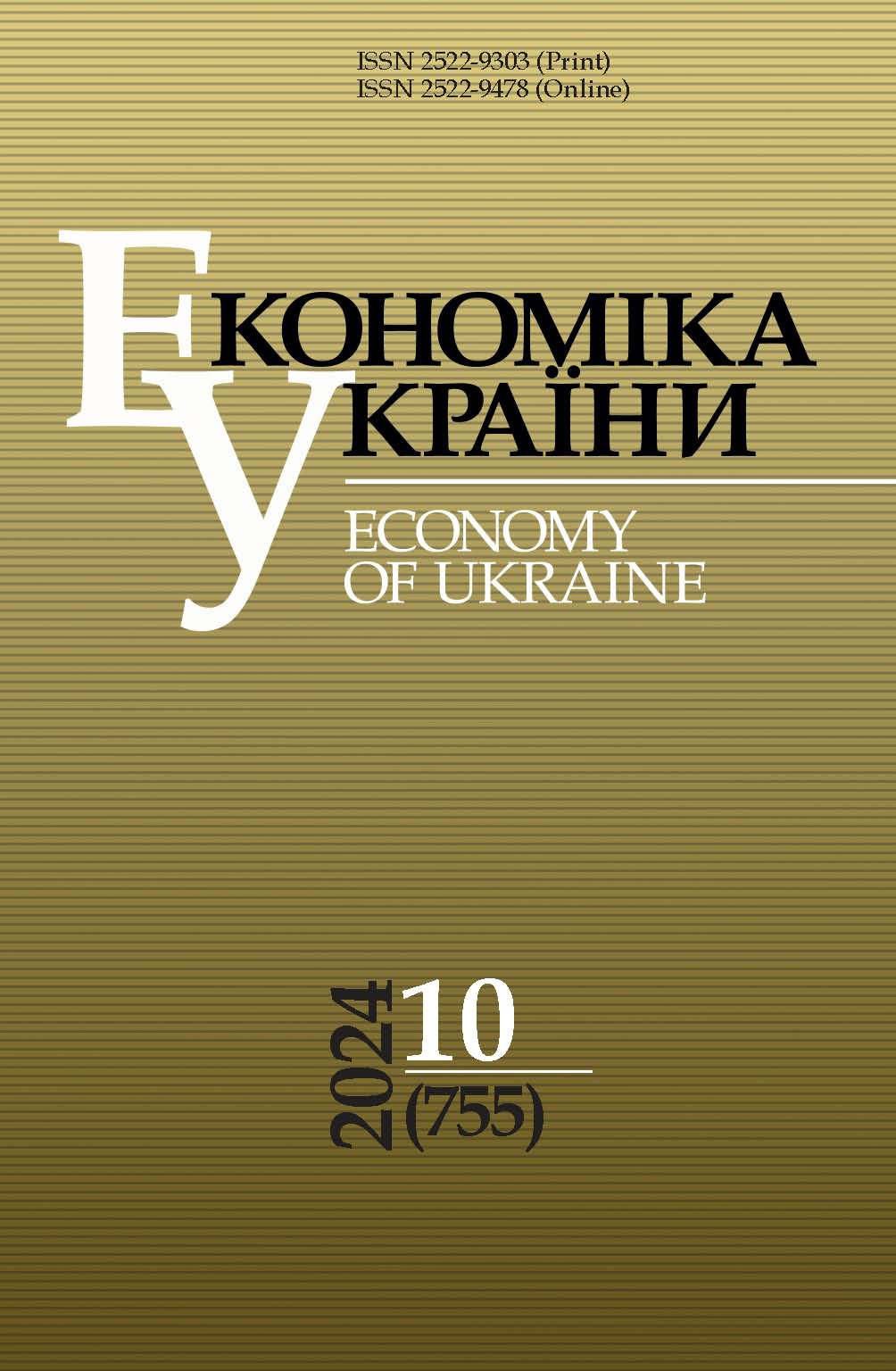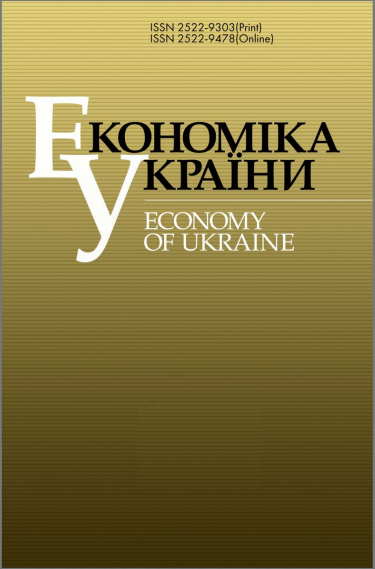MONETARY POLICY AND CREDIT SUPPORT OF THE ECONOMY IN CONDITIONS OF WAR AND GLOBAL INSTABILITY
DOI:
https://doi.org/10.15407/economyukr.2024.10.027Keywords:
monetary policy; bank lending; inflation targeting; money supply; global instability; financial mechanisms of developmentAbstract
The aggravation of global instability challenges, caused by the critical accumulation of socio-economic contradictions, foregrounds at the international level the problem of ensuring resilient development of the national economy, free from negative external influences. In this context, there is a need to revise existing approaches to the implementation of monetary policy as a tool for supporting resilient nationally rooted economic development.
It is shown that thanks to international aid in 2022-2023, unprecedented financial capital was formed in Ukrainian economy which is not used in the interests of economic reconstruction and defense, but is sterilized within the framework of the existing monetary regulation model in the NBU’s accounts, as well as in domestic government bonds and other liquid short-term instruments. This is a consequence of the weak institutional capacity of the state to freely use available financial resources, the inadequacy of chosen monetary policy model to current challenges and a certain manifestation of national de-sovereignization in the monetary sphere.
Tasks critical for the design of nationally rooted monetary policy and the productive functioning of Ukraine’s banking sector in wartime and in the period of post-war recovery are identified and substantiated. Such tasks are controllability of exchange rate and productive use of accumulated liquidity in the interests of economic development in priority directions. Implementation of the first point requires the development of currency control system using restrictions on foreign currency transactions and on the movement of cross-border capital flows. Solving the second task requires the involvement of specialized credit institutions with state participation. Financing of priority areas for the economy of a warring country involves the controllability of credit issuance process, supplemented by measures to localize the issued money supply with the entire array of monetary policy instruments available to the NBU.
References
Korablin, S. (2017). Macroeconomic dynamics of Ukraine: the trap of raw materials markets. Kyiv. 308 p. URL: http://ief.org.ua/docs/mg/292.pdf [in Ukrainian].
Bublyk, Ye. (2022). Strengthening foreign exchange regulation in Ukraine amid the escalation of hostilities. Economy of Ukraine. 65. 10 (731). 35-50. https://doi.org/10.15407/economyukr.2022.10.035 [in Ukrainian].
Bublyk, Ye. (Ed.) (2023). Effectiveness of monetary policy in Ukraine in conditions of global economic destabilization. Kyiv. 216 p. URL: http://ief.org.ua/wp-content/uploads/2023/12/Efektyvnist-hroshovo-kredytnoi-polityky-v-Ukraini.pdf [in Ukrainian].
Sleibi, Y., Casalin, F., Fazio, G. (2023). Unconventional monetary policies and credit co-movement in the Eurozone. Journal of International Financial Markets, Institutions and Money. Vol. 85. 101779. https://doi.org/10.1016/j.intfin.2023.101779
Heets’, V., Grytsenko, A. (2013). The way out from a crisis (Reflections about actual things after the reading). Economy of Ukraine. 56. 6 (619). 4-19. URL: http://nbuv.gov.ua/UJRN/EkUk_2013_6_2 [in Ukrainian].
Korablin, S. (2023). Inflation targeting in Ukraine: individual aspects, results and conclusions. Finance of Ukraine. No. 7. P. 37-53. https://doi.org./10.33763/finukr2023.07.037 [in Ukrainian].
Alesina, A., Ardagna, S., Perotti, R., Schiantarelli, F. (2002). Fiscal policy, profits, and investment. American economic review. 92(3). 571-589. https://doi.org./10.1257/00028280260136255
Horst, M., Neyer, U. (2020). The impact of quantitative easing on bank loan supply and monetary policy implementation in the euro area. Review of Economics. 70(3). 229-265. https://doi.org/10.1515/roe-2019-0033
De Grauwe, P., Ji, Y. (2024). How to conduct monetary policies. The ECB in the past, present and future. Journal of International Money and Finance. Vol. 143. https://doi.org/10.1016/j.jimonfin.2024.103048
Martins, A. (2024). Banks stock market reaction to the Italian and Spanish windfall tax announcement: an event study. Journal of Bank Regulation. May 08. https://doi.org/10.1057/s41261-024-00246-x
Shapoval, Yu. (2023). Ukraine’s monetary policy during the war and post-war periods (according to the materials of report at the meeting of the Presidium of the NAS of Ukraine, May 3, 2023). Visn. Nac. Acad. Nauk Ukr. No. 7. P. 79-85. https://doi.org/10.15407/visn2023.07.079 [in Ukrainian].
Harkavenko, V., Yershova, G. (2023). Interest rate policy of the National Bank of Ukraine and its impact on the country's economy. Economy of Ukraine. 66. 11 (744). 27-51. https://doi.org/10.15407/economyukr.2023.11.027 [in Ukrainian].
Hemming, R., Kell, M., Mahfouz, S. (2002). The effectiveness of fiscal policy in stimulating economic activity: A review of the literature. IMF Working papers. No. 2002/208. 52 p. URL: https://econpapers.repec.org/paper/imfimfwpa/2002_2f208.htm
Berk, J., van den End, J. (2022). Excess liquidity and the usefulness of the money multiplier. Credit and Capital Markets – Kredit und Kapital. Vol. 55. Iss. 4. P. 457-488. https://doi.org/10.3790/ccm.55.4.457
Dziubliuk, O. (2023). Problems of intensification of bank lending to the real sector of the economy in the conditions of martial law. Herald of Economics. Vol. 3. P. 8-25. https://doi.org/10.35774/visnyk2023.03.008 [in Ukrainian].
Johnson, C. (2007). MITI and the Japanese Miracle: The Growth of Industrial Policy, 1925–1975. Stanford, Calif., Stanford University Press, 409 p. https://doi.org/10.1017/S0008423900023702
Mazzucato, M., Penna, C. (2016). Beyond market failures: The market creating and shaping roles of state investment banks. Journal of economic policy reform. 19(4). 305-326. https://doi.org/10.1080/17487870.2016.1216416
Grytsenko, A. (2023). Nationally rooted economic development as a local response to the global geoeconomic shifts. Economy of Ukraine. 66. 4 (737). 38-54. https://doi.org/10.15407/economyukr.2023.04.038 [in Ukrainian].
Downloads
Published
How to Cite
Issue
Section
License
Copyright (c) 2024 Publisher PH "Academperiodyka" of the NAS of Ukraine

This work is licensed under a Creative Commons Attribution-NonCommercial-NoDerivatives 4.0 International License.



